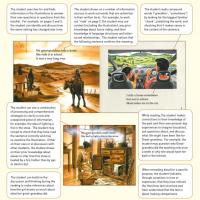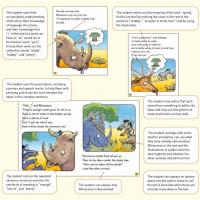We start reading on day 1!
learning the letter sounds...
Reading in the tepee...
Reading lesson at our cool learning table...
The learning table can be used as a white board...
Discussing and responding to our reading books!
We learn the letters and the sounds by using Jolly Phonics and Yoland Soryl's method.
http://www.yolandasoryl.com
http://jollylearning.co.uk/overview-about-jolly-phonics/
We read short poems, we read our own writing and we read a book at Magenta level.
I aim for the children to be at Red level in a very short time, as this is the level where the real reading starts. The text is too long for children to memorise, so they have to pay close attention to the written word.
We use a reading programme called Reading Rockets.
Children start at Magenta level, followed by Red level.
The reading standard
After one year at school, students will read, respond to, and think critically about fiction and non-fiction texts at the green level of Ready to Read (the core instructional series that supports reading in The New Zealand Curriculum).
Key characteristics of texts at green level
Texts at green level have been designed with characteristics that include:
- generally familiar contexts and settings
- one text form, and one main storyline or topic, for each text
- most content explicitly stated but also some implicit content that provides opportunities for students to make simple inferences
- illustrations that support and extend the meaning but may not exactly match the words
- many high-frequency words
- topic words and interest words (including a wide range of regular and irregular verbs and some adjectives and adverbs) that are likely to be in a reader's oral vocabulary and that are strongly supported by the context or illustrations
- some visual language features such as diagrams or speech bubbles
- sentences that run over more than one line but do not split phrases
- dialogue between easily identified speakers
- a range of punctuation, including speech marks and commas, to support phrasing and meaning.
These characteristics support the development of reading behaviours that are illustrated here.
Illustrating the reading standard
The Way it Was by Dot Meharry; illustrated by Spike Wademan
This text is levelled at Green 1.
In this non-fiction text, a young girl compares her life with that of her great-grandma. The illustrations expand on the information given in the written text.
The text follows a 'then/now' pattern, with the narrator stating what is the same for her and her great-grandma and what is different. The time difference is reinforced by the use of colour (sepia for the past and full colour for the present day) and by the use of content-specific vocabulary, such as 'great-grandma', 'fire', and 'stove'.
This example highlights the sorts of reading behaviours teachers could expect to observe in students who are meeting the standard. Sometimes these behaviours will be in response to teacher prompts and questions, and sometimes they will be spontaneous as the students notice and respond to the ideas in the text. These behaviours may be during the first or subsequent readings and discussion.
A Good Idea by Bill Nagelkerke; illustrated by Jeffy James
This text is levelled at Green 3.
This humorous narrative is about four animals who want to find some relief from the blazing African sun. The setting may be outside the direct experience of most students, but it is likely to link to their indirect experience of Africa through television, movies, and video.
The text has a repetitive, cumulative structure, and much of the story is conveyed through dialogue. The illustrations and other visual language features, such as thought bubbles, speech bubbles, and the use of colour (yellow for heat and blue for shade) support the meaning and add to the humour.
Because A Good Idea is available as a big book as well as a small book, students are likely to have been introduced to it within a shared reading lesson.
The story’s theme is the importance of thinking and co-operation to solve problems.
This example highlights the sorts of reading behaviours teachers could expect to observe in students who are meeting the standard. Sometimes these behaviours will be in response to teacher prompts and questions, and sometimes they will be spontaneous as the students notice and respond to the ideas in the text. These behaviours may be during the first or subsequent readings and discussion.














No comments:
Post a Comment